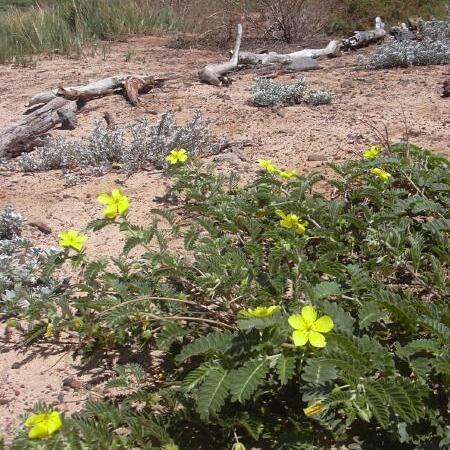Annual pubescent or rarely glabrous herbs, sometimes of biennial or perennial growth with woody basal stock; hairs unicellar with bulbous bases; branches usually prostrate but in some species apparently decumbent or erect. Leaves paired at each node, one markedly smaller than the other (small and large leaves alternating at consecutive nodes), paripinnate; leaflets in 5-10 pairs, sessile, unequal-sided, oblong to ovate; stipules 2, lanceolate to ovate, membranous. Flowers solitary at each node, subtended by the smaller leaf, 5-merous, regular, 5-40 mm. across. Sepals 5, ovate to narrowly lanceolate, hairy outside, deciduous or rarely persistent. Petals 5, white to golden yellow, narrowly lanceolate to broadly ovate, 2-22 × 1-18 mm., rarely equal to and usually 2-3 times as long as the sepals. Stamens 5-10; smaller flowers (5-8 mm. across) usually have 5 stamens in 1 whorl, medium-sized flowers (8-20 mm. across) have 6-8 stamens, while large flowers (over 20 mm. across) have 8-10 stamens in 2 whorls; the outer whorl consists usually of 5 stamens; anthers oblong-cordate; filaments without scales; intrastaminal glands 10, free or connate to form a shallow cup at the base of the ovary. Ovary sessile, covered with erect bristle-like hairs, 5-lobed, 5-locular, each locule with 2-5 ovules; style rather short to absent; stigma conspicuous, pyramidal or hemispherical. Fruit 5-angled, disc-or cone-shaped, splitting at length into 5 indehiscent mericarps; mericarp dorsally unarmed, spinous or winged, 2-5-seeded. Seeds without endosperm.
Annual or occasionally perennial herbs, very rarely shrubby; stems herbaceous to suffrutescent, diffusely branched, prostrate to decumbent or ascending, terete, somewhat succulent, becoming striate on drying, densely pubescent to glabrate, spreading radially from a central tap root to 3 m long. Leaves opposite, elliptical, abruptly even-pinnate, one of each pair alternately smaller or sometimes aborting; leaflets 3-10 pairs, opposite, entire, sessile to very shortly petiolulate, oblong to ovate or elliptical, terminal pair pointed forward, pubescent; stipules foliaceous. Flowers solitary, pseudaxillary, regular; peduncles emerging from axils of alter-nately smaller leaves; sepals 5, free, pubescent, caducous; petals 5, bright yellow or rarely white, the base darker, free, spreading hemispherically, deciduous, im-bricate; disc fleshy, annular, 10-lobed; stamens 10, 5 opposite petals exterior, somewhat longer, and adnate basally to petals, 5 opposite sepals subtended to exterior and interior by nectariferous glands, the intrastaminal glands free or connate to form an urceolate ring surrounding ovary base, the filaments filiform
Prostrate, usually pubescent, annual herbs, more rarely small erect shrubs. Leaves opposite, in unequal pairs or, more rarely, by suppression of the smaller of the pair, alternate, not succulent, 3-or more-foliolate; petiole terete; leaflets not continuous with petiole, not stipellate. Pedicel usually erect in flower. Sepals 5, not persistent in fruit. Petals 5, quickly caducous, longer than sepals, yellow, not fading to white. Stamens 10 or fewer, rarely 12 in some T. suberosus flowers, usually in 2 subequal whorls; filaments not winged. Extrastaminal nectariferous disc 5-lobed; intrastaminal disc of 5 free lobes or sinuate ring or lacking. Ovary 5-celled; ovules 1–5 per cell; stigma 5-ridged, papillose. Fruit a schizocarp, pendent in shrubby species, erect in prostrate species, dissociating into 2–5 indehiscent, tuberculate, spiny or 2-winged cocci; pedicel ?erect.
or subulate, unappendaged, inserted on disc, the anthers cordate to sagittate; ovary sessile, 5-lobed and-loculed, ovoid or globose, densely pubescent, the ovules 3-5 per locule, pendulous, superposed in 2 vertical rows on placenta, placentation axile, the style simple, stout, cylindrical, 5-ridged, deciduous, the stigma terminal, pyramidal or globose, 5-lobed, papillose. Fruit 5-angled, horizontally depressed, pubescent, at maturity dividing septicidally and separating into 5 or rarely fewer mericarps and leaving no central axis; mericarps broadly triangular, each divided internally by oblique transverse septa into 2-5 1-seeded compartments, spiny or winged or rarely only tuberculate abaxially; seeds oblong-ovoid, obliquely pen-dulous, horizontally arranged one above the other, the testa membranaceous, the embryo straight, endosperm absent.-x=6.
Prostrate hairy herbs. Leaves opposite, paripinnate, mostly anisophyllous; stipules present. Flowers actinomorphic, 5-merous, bisexual, solitary on pseudo-axillary peduncles, white or yellow. Sepals 5, free, imbricate, persistent or caducous. Petals 5, free, patent, imbricate, fugacious. Disk present. Stamens 10, subequal or unequal; anthers dorsifixed. Ovary superior, sessile, hairy, 5-12-lobed, 5-12-celled; style short and thick, with 5-12 decurrent stigmas; cells with 3 or more ovules. Fruit 5-angled or 5-12-winged; cocci partly abortive, spinous or tuberculate, indehiscent with 3-5 superposed seeds separated by septa.
Sep caducous; stamens mostly 2 or 3 times as many as the pet; nectary-glands both intra-and extrastaminal; ovary 5-locular, with 5–10 ovules per locule; fr spiny, beakless, splitting at maturity into 5 segments, each transversely septate into 3–5 1-seeded compartments; germination hypogeal; diffusely branched, prostrate herbs with opposite, even-pinnate lvs and small yellow fls solitary at the axils. 30, Old World.
Herbs, annual or biennial, prostrate. Leaves opposite, pinnate. Flowers axillary, solitary. Sepals 5. Petals 5, yellow, imbricate. Disk ring-shaped. Stamens 10, with glands, outer 5 longer and opposite petals, inner 5 shorter and alternate with petals. Fruit a schizocarp of 4 or 5 indehiscent prickly carpels. Seeds obliquely pendulous; endosperm thinly membranous.
Ovary 5-lobed, consisting of 5 concrescent carpels with 3–5 ovules in each carpel, densely covered with stiff erect hairs; stigma 5-angled, pyramidal or hemispheric, formed by fusion of the 5 stigmatic lobes.
Stamens 10 (very rarely 5, but not in species of our area); filaments subulate, with extra-and intrastaminal glands at the base; anthers cordate or oblong-cordate.
Leaves opposite, one of each pair usually longer than the other, paripinnate; leaflets opposite, sessile or very shortly petiolate, entire and somewhat oblique.
Annual or perennial xerophilous herbs, sometimes with a woody base, very rarely shrubby, with usually prostrate or ascending branches.
Fruit at length breaking up into 5 cocci; cocci dorsally tuberculate and provided with spines or wings, rarely unarmed, 1–5-seeded.
Petals 5, usually yellow, rarely white, shorter to longer than the sepals, spreading.
Sepals 5, deciduous or sometimes persistent.
Flowers solitary, axillary.
Seeds without endosperm.
Stipules herbaceous.


